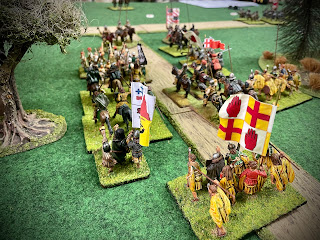Two more games this week this time getting the Irish out for a test drive.
Now I'm no expert, but I'm learning fast and so my knowledge of Irish warfare is limited to Ian Heath's 16th Century Armies and the recent Tudor Warfare Vol2 by Jonathan Davies supplemented by a wee bit of Gush's Renaissance Armies. A broad though shallow sweep.
How to represent them on the table?
- Kern as Infantry but able to fight and move through bad terrain
- Gallowglass as Swords - no change there
- Irish Cavalry as Reiter - not Caracoling but skirmishing with darts, so no change
- No Cavalry - so can swap for loose shotte (essentially skirmishers), or more Kern or Gallowglass
- Irish can have a unit of "normal" pike and shot infantry
So now we have .
- National type army lists (basic but getting there)
- Card driven activation (tried last week and works well)
- Random events when the random event card was drawn (not tried yet)
- Leaders with traits which could effect the game (not tried)
- Campaign rules with casualty recovery. (not tried)
Game one - Capture the gun
Both sides tried to capture a cannon which had become bogged down in a ford. The side which held it at the end of the game won. Not very subtle and probably favouring the English but the random activation meant that either side had complete control. I've also introduced Random Events so there were a few time when things went "agley". The English were lead by an officer keen on glory and leading from the front but this was a game where shooting would be handy. The Irish on the other had had an officer who had god in his side and who could rally off hits from units he was attached to by his inspirational presence. Things were perhaps more even.
Both sides moved up to the ford and the line of the river, but as expected the English had the upper hand. The Irish weren't able to get to grips, but their skirmishing horse did wear down the heavier English Cavalry and Border Horse and drove them off the table. This gave the English a bit of a wobble and forced one of the back. The Irish had meanwhile be somewhat restored by their inspirational leader and now had the advantage of numbers but pressing the attack was difficult. The worn out English lost another unit, now down to three. This unit had the English leader, still spoiling for a fight and he was slain and in the morale test another ran off. Suddenly there were only two English pike, a ways from the ford, leaderless and without any powder.....the Irish had won.
The tweaks to the rules had made the game interesting, challenging and given a good player the opportunity to get the best from his troops. Most importantly everyone who played, enjoyed it.
Game two was a scenario from the One Hour Wargames book. This time the English deployed two units just below a cross roads flanked by difficult ground (bog in our games). There was some debate about whether the Irish would drag their new cannon along. The decided it would be worth the effort - it wasn't. It fired a shot and ran out of ammo, perhaps fitting given they weren't known for deploying them! Their men surged forward, Gallowglass moving through the bog to try and flank the English. Their first move didn't go well - after taking casualties from the Irish horse one unit drew a random event and recoiled a full move, leaving the other unit dangerously exposed. A series of short turns however meant they were still fighting when their cavalry, weakened by the last game, but still functioning, turned up and stopped the Irish advance, the solid ground between the bogs was now a bottleneck and units had no space to deploy to shoot or turn to fight. Time was running out. One unit of English infantry were wiped out and the Irish cavalry dashed for the crossroads but they were shot down by English calivers. That was the last turn and the game was over.
Two games so good results and the rule amendments seem to give good games too. The Irish need some work to make them a bit more skirmishy but not much. I do need some more figs. Some Irish horse and handgunners as well as that Pike a Shot unit.












